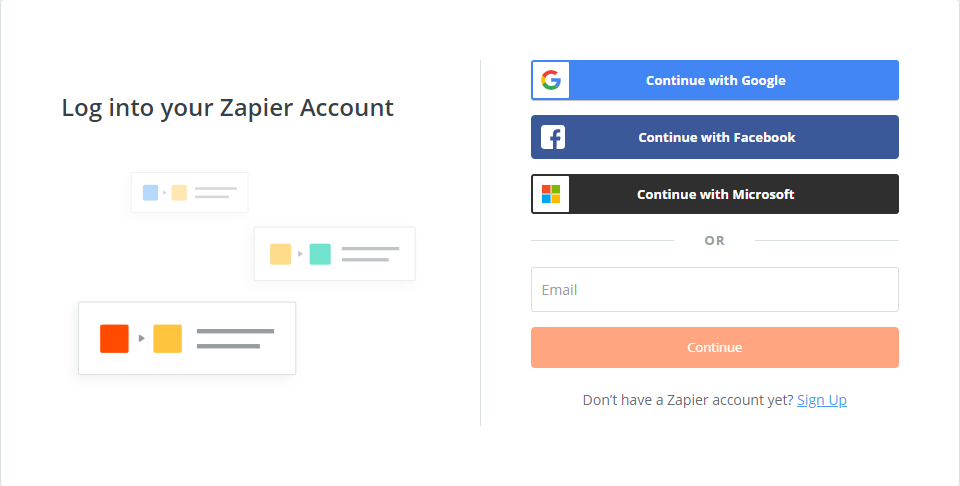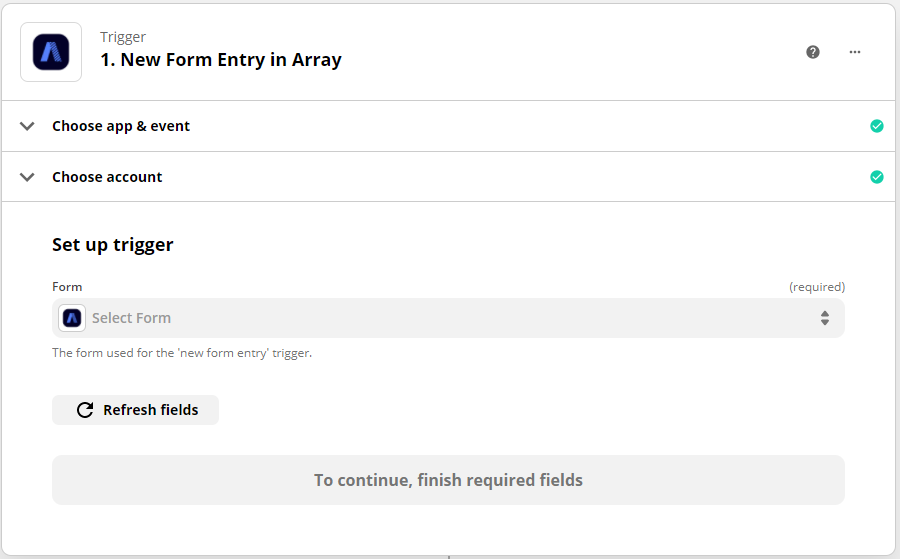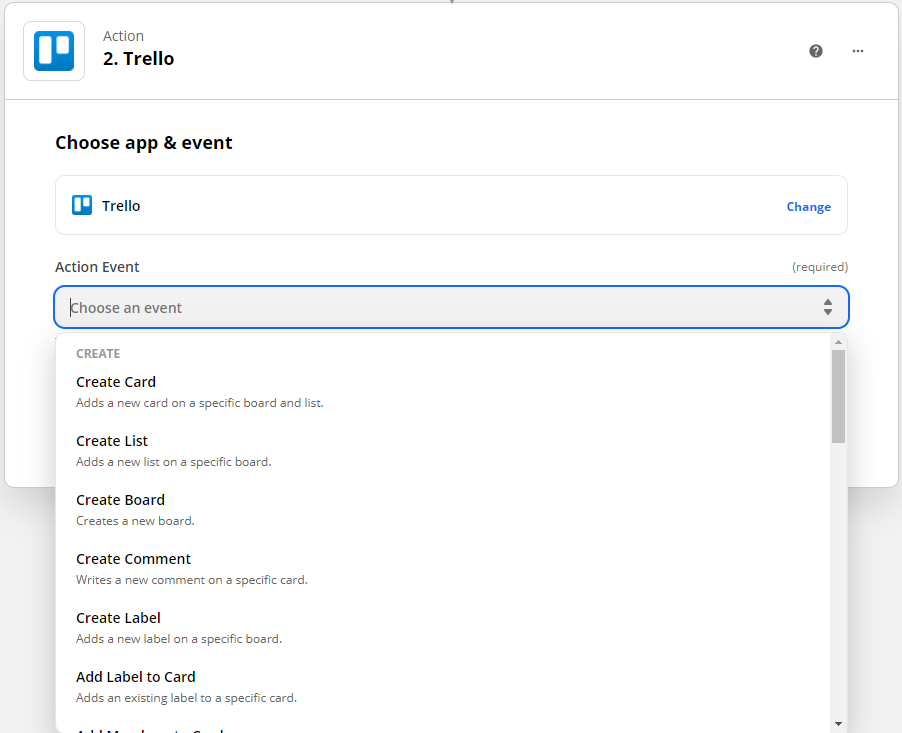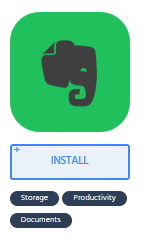Zapier Integration with Evernote
Array is great at capturing and interpreting data, but that’s only one aspect of any workflow. Often, teams will use a one-stop workspace such as Evernote to store all relevant notes, emails, or documents associated with a given project.
By utilizing Array’s integration with Evernote, users can save their Array reports directly into Evernote, providing a clearer picture of how the data fits into the project as a whole. The integration also enables data to be pulled from a spreadsheet in Evernote directly into a Array form, ensuring that your questions align with the data you’ve already been collecting.
In this article, we'll be showing you how to:
- Create a new note in Evernote containing an editable copy of a Array form response
- Save a PDF backup of Array response forms in Evernote
- Send documents and media files to Evernote from Array
- Create a spreadsheet in Evernote from within a Array form
- Populate a Array form with information from Evernote
How to set up Zapier
If you would like to get started using Zapier, click the link here to locate to Array/Zapier setup.
You will need to ensure you have a Zapier account set up. Visit Zapier's login page to set up your account

If you have an existing account then login with your details.
Once you have created an account the integration is set up and you can begin to set up your Zaps in Zapier.
Setting up a Trigger
First, start by signing into your Zapier account.
Either navigate to the admin dashboard of your account on the left hand side menu and click on 'Zaps'

Or select the large 'Make a Zap' button to begin.

You will be taken to a page where it will show you all applications you have linked to your account.
This is where we begin. Zapier will walk you through each step so you can set up your zaps correctly.
If Array is not linked to your Zapier account begin by searching for Array and adding your account. This is what Zapier call a 'Trigger App' to start the process.

You are then directed to choose a trigger that will cause your new Zap to happen. This could be when a form is submitted or if you want the process to occur after administration of your submission, you may want to start the Zap when a form is updated.

For this example, we have selected 'New Form Entry'

Now you will need to sign in to your Array account by clicking on 'Sign in to Array'

A pop up window will appear to put your log in details in.

Now select the form that you would like the action to happen upon. You can either search for the form or look at the drop-down that is produced.

If your form is not shown, select the 'Load More' button to load more.

If this does not work, you can use the advanced feature to locate your form with the Unique ID produced at the end of the form URL. To understand this more follow the doc here.

You need to ensure at least one submission of the form has been completed on Array for Zapier to pick up and test the form itself.

Once this has been successful you will move onto the application you want to connect with in exactly the same manner, expect you will be choosing what you want to happen to that submission/data on that form. This is called the 'Action'.
Setting up an Action
Firstly, Select your Action Application. If you have not already linked any to your account this is where you will be asked to do so. You will be provided with a long list of apps to choose from as well as built-in software you may already use. Either search for the application in the search bar or scroll the page to see what apps are available.

In this example, I shall choose Trello.
Next stages you are asked what you want the action to be. You will see on Trello you have a few options but this could range from anything to set up a calendar event with the specific date on the form to sending specific data on the form to Asana or another CRM. There are hundreds of actions and depending on the app/software will depend on the Zaps that can be performed.
Here for Trello I have the option to Create a new List/Board/Card and more or search for Find Board/Find Member/Find Card and more. Depending on your action will depend which one you choose. each has a description so can be understood easily.

Once you have chosen your action to perform you will be asked to link your account so Zapier has access to send the data to. This will run a quick test to ensure it has access and you can continue.

Once linked you will be asked to select what/where you want that data to go. There will be a number of options here and some will be mandatory and others will not depend if you want that information to be passed over. Each Zap will have its own criteria here.

You will then again be asked to confirm the steps in tis action and complete a test which will send a test to your desired location just like it was an action.
Once completed, Click finish, Ensure your Zap has a name and you will be all good to go. Just sit back, relax and watch the magic happen with all those submissions!

Once you have a few Zaps in place its time to start submitting forms and watching the magic happen. Zapier not only frees up valuable time you need for other tasks but it takes the worry of mundane tasks away so you can focus more on what does need to be completed.
What is Evernote?
Evernote is a cloud-based workspace to write, collect, share, and present your business or personal notes. By acting as your external brain, Evernote remembers everything — so you don’t have to.
If you don’t already have an Evernote account, you can create one here.
Integrating Evernote
Once you’ve created an account with Evernote, you’re able to connect it with Array. First, visit our Array Market and search for the Evernote integration. (You’ll be able to peruse our other integrations here as well.) The Market can be found through the “Installed Apps” panel found in the navigation bar at the top of your account.
Alternatively, you can go straight to the Evernote integration page by following this link.
Next you’ll need to activate the integration, which you can do by clicking the “Install” button.

You will be brought to a login screen asking for your Evernote account credentials. Enter your information so Array can access your account.
You’ll now see your Evernote account listed as being attached to Array. To connect another account, click the “Add Evernote account” button.

Disconnecting Evernote
To disconnect your Evernote account from Array, click the X to the right of the account email. Be aware that any forms with fields that use the Evernote integration will stop working properly.
Save Responses as New Evernote Notes
The Evernote integration allows users to automatically create a new Evernote note containing the responder’s information each time a form is submitted.
To make use of this feature, open the desired form and navigate to the 'Connect' at the Top of the Form Builder.

Next, head to the Storage tab and open the Evernote option.

You will then have the option to select how and where you’d like to save the information in Evernote. To start, specify the notebook you’d like to contain all your responses.
You can also add tags to your notes, helping to categorize the responses.

Finally, select how you’d like to save your data. The most fundamental option is the “Text” option, which will record each of the user’s responses in an Evernote note. Each new form response will create its own new, individual note in Evernote. Be aware that text notes of this sort can be edited from within the Evernote app.
Save Media Files to Evernote
Array forms can support many types of media, such as images, videos, or audio files — in addition to traditional file attachments. If you’d like to include a media file in your Evernote text notes, simply click the green check box next to their icon.
Save PDF Copy to Evernote
Users can also save a carbon copy PDF to their Evernote accounts. As with media files, this is done by selecting the PDF option from the list of available file types. Your PDF will appear at the bottom of your Evernote text note.
Create Spreadsheets in Evernote
Sometimes, you may want to look at all your response data in one document, as opposed to having to go back and forth between individual Evernote notes. In this case, use the CSV or Excel storage options.
A new Evernote note containing the selected file type will be created the first time a Array form is submitted. For each successive response, the CSV or Excel file will automatically update by adding a new row to the bottom of the document. Each question in your Array form will appear on the spreadsheet as its own column.
Pull Data From Evernote
Using Data Search, the Evernote integration works in two directions. In addition to sending response information to Evernote, it can also auto-populate a Array form based on data found in an Evernote spreadsheet. This is done by making use of our Data Search feature, found in the Text Element section of the form toolbox.
After dropping the Data Search field into your form, a popup screen will ask you to specify from which source you’d like to search. Select Evernote.
Finally, Array will display each of the column titles found in the specified spreadsheet. Select those that apply to your search.
When you are finished, your Array form will include a “Search Evernote” field. Responders can use this tool to find their data in the spreadsheet and quickly fill in the correlating data, saving time.
Visit our Data Search support article to learn more about the feature.
Related Articles
Zapier Integration
Zapier is an automation tool that will bolt onto existing software and perform day to day, repetitive, mundane tasks. With Array releasing our integrations, it opens up a whole new world of opportunities for automation between existing software that ...Zapier Integration with Dropbox
Dropbox is great for centralizing a team or company’s valuable documents. Dropbox is great for centralizing a team or company’s valuable documents, but sometimes it can be difficult to make sense of everything later. With Array’s Dropbox integration, ...Zapier Integration with MailChimp
A healthy, engaged email mailing list is a marketer’s favorite asset. A healthy, engaged email mailing list is a marketer’s favourite asset. It provides a direct line of communication with a body of customers who’ve already expressed a willingness to ...Zapier Integration with Google Calendar
The Google Calendar integration in Array makes it easy to add events to a team’s schedule regardless of its size. As an organization grows, it becomes increasing difficult to keep track of everyone’s schedule. In most cases, access to a centralized ...Zapier Integration with Zendesk Sell
Zendesk Sell is a customer-relations management software focused on optimizing the sales pipeline of a growing business. Maintaining and growing a healthy list of sales leads plays a pivotal role for any marketing team’s success. It provides the fuel ...